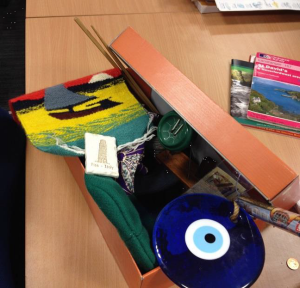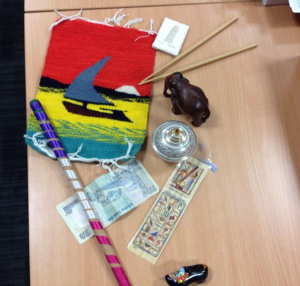13
How to ditch technology and think inside the box - the Culture Shoe Box
Dr. Hoda S. Wassif and Maged Zakher
You turn up to your classroom and the internet is down or the computers are not working! Imagine the frustration. Can we still deliver engaging sessions with no technology?
Using technology in the classroom seems to be ‘unquestionable’! We need to be cool, up-to-date and as engaging as possible. However, – and there is a big ‘however’ here! – students seem to be bombarded by technology all the time, not only as learners but as citizens of the world in this era. We thought ‘No slides! Let’s think inside the box; let’s at least practise what we preach.’ And here it is: the Culture Shoe Box (CSB).
The Culture Shoe Box (CSB) is a new, inexpensive, hands-on educational resource that can be used to facilitate workshops and enhance students’ experience. It was developed using an empty shoe box that was filled with cultural items (e.g. a papyrus bookmark, some hand-made items from different parts of the world, and a traditional African shirt among other things, see photos). Students were encouraged to donate cultural items that are inexpensive and could fit inside the CSB. When a student donates an item to the CSB, they are asked to tell the class about the item, how it is significant, what cultural values/dimensions it represents, etc.
Impact? The different nature of this educational tool adds an exotic feel to the learning sessions we run. When discussing topics such as culture, ethics, values, views, etc. the tool comes in handy and generates some rich discussions.
How can you use it? One way is to ask students to pick from the box an item they like and apply what they have learned on that day through the item on the theme of cultural ethics, business management, etc. Students enjoy discussing themes such as ‘the evil eye’, ‘hierarchical structures’, ‘marriage commitment’, ‘luck’ and others while inspecting real cultural items at their tables. Some artefacts spark discussions not directly related to the item; for example a 3-legged mug holding the symbol of the Isle of Man led to the discussion of the morality of tax avoidance schemes on the island.
The ‘bring-an-item-and-tell-us-about-it’ task and the engagement with real cultural artefacts foster contribution-and-discovery-based learning rather than simply receiving information.
Can you use it in your classes? Why not give it a go? You could use it as a filler (when you’ve got those extra 15 minutes and you don’t really know what to do), a revision tool, an ice-breaker, or even as the main focus of a whole teaching session. Whether you teach culture, ethics, tolerance, negotiations, management, or even international relations, you can always find something to start a free discussion using a cultural item from the box. Want to even improvise? Have your students develop their own culture shoe boxes in groups. When we started our presentation at the HEA conference, we threw this quick task: ‘open the box and pick an item that reflects your idea about learning and teaching.’ A mug, a wooden Indian elephant (or is it African?), a tourist information guide, and chopsticks were among the items people picked. The discussion that followed wouldn’t have been that rich if we hadn’t ditched technology 🙂 The group talked about studying habits, huge problems that teachers try to ignore (like the elephant in the room), preparing the way ahead for students to follow and much more themes.
You don’t have to really ditch technology altogether; just try adding an element of exotic fun where your learners can actually see and touch real objects while giving them the freedom of deeper discussions.
It is not as simple as ‘look for a few cultural items lying around at your house and start our own Culture Shoe Box;’ your teaching abilities and enthusiasm about the topics you teach will always play a big role in your classes with one tool or another. If you decide to give this tool a go, think of the possibilities of topics that could arise by some items; prepare which lines you may want the discussions to go along; and make sure to join in the fun in store for your students to experience. After all, your students may feel they are learning in a cooler and different way if you just think inside the box – the Culture Shoe Box!
as simple as ‘look for a few cultural items lying around at your house and start our own Culture Shoe Box;’ your teaching abilities and enthusiasm about the topics you teach will always play a big role in your classes with one tool or another. If you decide to give this tool a go, think of the possibilities of topics that could arise by some items; prepare which lines you may want the discussions to go along; and make sure to join in the fun in store for your students to experience. After all, your students may feel they are learning in a cooler and different way if you just think inside the box – the Culture Shoe Box!
